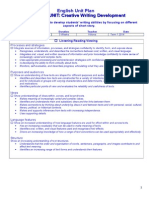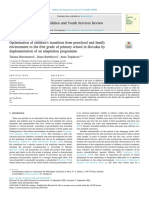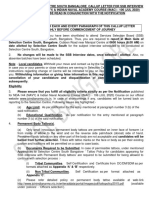The IB DP English Learner Portfolio
The IB DP English Learner Portfolio
Uploaded by
Vikas TanwarCopyright:
Available Formats
The IB DP English Learner Portfolio
The IB DP English Learner Portfolio
Uploaded by
Vikas TanwarCopyright
Available Formats
Share this document
Did you find this document useful?
Is this content inappropriate?
Copyright:
Available Formats
The IB DP English Learner Portfolio
The IB DP English Learner Portfolio
Uploaded by
Vikas TanwarCopyright:
Available Formats
The IB DP English Learner Portfolio
Source: IB Language A: Literature Guide & L. Krumvieda’s DP Training Activity Book
The learner portfolio is a central element of the language A: literature course and is mandatory for all
students. It is an individual collection of student work compiled during the two years of the course. The learner
portfolio is a place for you to explore and reflect on literary texts, as well as establish connections between them and
with the areas of exploration and the central concepts in the subject. In the learner portfolio, you will be expected to
reflect on your responses to the works being studied in the corresponding area of exploration. You will also be
expected to establish connections between these works and previous ones you have read, and between your
perspectives and values as a reader and those of your peers. As you progress through the syllabus, it is expected that
these connections will be drawn between works within and across areas of exploration, and that they will provide a
foundation for the construction of broader knowledge about the transactions between texts, culture and identity.
The learner portfolio is also a space in which you can prepare for assessment. You will use the portfolio to
make decisions about the most appropriate and productive connections between the works we have studied and the
assessment components. It will be introduced at the beginning of the course and become increasingly important as
you progress and prepare for external and internal assessment.
The learner portfolio must consist of a diversity of formal and informal responses to the works studied,
which may come in a range of critical and/or creative forms, and in different media. It is your own record of
discovery and development throughout the course. It could be used to document:
• reflections related to the guiding conceptual questions of the course
• reflections on the assumptions, beliefs, and values that frame a response to texts
• explorations of texts and the insights they offer into social, global and real-world issues
• detailed evaluations and critical analyses of works, texts or extracts, which explore the potential meanings for
language used in them
• reflections on the connections across a range of texts studied
• experiments with form, media and technology
• creative writing tasks for exploration of different literary forms and development of your personal responses
to works
• reading, research and inquiry carried out beyond the classroom experience
• records of valued feedback received
• reports of classroom or group activities or discussions that explore the diverse values and perspectives
negotiated and the process of negotiation in itself
• challenges faced and achievements
• selections of suitable extracts that could form the basis of the Individual Oral
• instances of self-assessment to evaluate your own progress
The Learner Portfolio is about THE PROCESS, not the product. It should not be a collection of your best
work and final drafts, but your ideas, brainstorms, connections and deeper ideas and insights you have regarding the
units we are covering in DP 1 and DP 2. Essentially, you are creating your own personal textbook for this two-year
class. There are plenty of ways to organize it: chronologically, by genre, by global issues, the three Areas of
Exploration, the seven concepts, etc. The portfolio can be done in many forms: a comp book, a journal, a website, a
blog, vlog, google slides or docs, etc. Whatever form it is in, you need to make sure that the teacher can have free
and unfettered access to it 24/7. Platforms that are NOT acceptable are ones that require a password that you control,
requires membership (i.e. Facebook, Pinterest, etc.)
In order to hold you accountable, the portfolio will be checked periodically and will be worth points in the
class. However, an awareness of the importance of this portfolio is warranted. If you don’t put much effort or
thought into this, your recollections or ideas about the works covered over the two years will be sketchy at best,
completely forgotten at worst, and will leave you with little to draw from when you go into the four assessments
over the two-year period. I would suggest that you do at least one or two entries each week, in order to stay on top of
it.
You might also like
- Persepolis Discussion Questions 1Document3 pagesPersepolis Discussion Questions 1api-685172329No ratings yet
- Persepolis IODocument1 pagePersepolis IOVikas Tanwar100% (1)
- The Handmaids Tale Lesson PlanDocument8 pagesThe Handmaids Tale Lesson PlanNehal Ezz El-Dein0% (1)
- Alyce Spicers Ubd Unit PlanDocument23 pagesAlyce Spicers Ubd Unit Planapi-296903618No ratings yet
- 17 Lesson Plan - Way Home-1Document3 pages17 Lesson Plan - Way Home-1Alison Hawken100% (3)
- WORK SHEET 1.1 ON CHAPTER 4.1 The Role of Marketing (IBDP)Document2 pagesWORK SHEET 1.1 ON CHAPTER 4.1 The Role of Marketing (IBDP)Vikas TanwarNo ratings yet
- Module 2 - L.E. 4 Non-Literary Unit PlanDocument6 pagesModule 2 - L.E. 4 Non-Literary Unit PlanPreston HoppersNo ratings yet
- Persepolis - Unit PlanDocument8 pagesPersepolis - Unit Planapi-400626824No ratings yet
- Tkam MypDocument5 pagesTkam Mypapi-300759812100% (1)
- Lit - New Course Materials PDFDocument134 pagesLit - New Course Materials PDFIsabelle OngNo ratings yet
- Assessment Rubric Paper 2 SL Eng Lang and LitDocument1 pageAssessment Rubric Paper 2 SL Eng Lang and LitTodd Albert SchryverNo ratings yet
- Narrative Writing Unit PlanDocument4 pagesNarrative Writing Unit PlanDonny HughesNo ratings yet
- Romeo Juliet Unit PlanDocument15 pagesRomeo Juliet Unit Planapi-285066070100% (1)
- Young Adult Literature Lesson PlanDocument8 pagesYoung Adult Literature Lesson PlanArgel OrbistaNo ratings yet
- Ib English Language and Literature: Course OutlineDocument3 pagesIb English Language and Literature: Course OutlineSiddhant MaheshwariNo ratings yet
- Case Study 1: Oasis Hong Kong AirlinesDocument7 pagesCase Study 1: Oasis Hong Kong AirlinesVikas TanwarNo ratings yet
- The Meaning of The Media ImageDocument3 pagesThe Meaning of The Media ImageEdward StapelNo ratings yet
- The HL Essay - Key Information, Processes and ResourcesDocument41 pagesThe HL Essay - Key Information, Processes and ResourcesRahiq HatemNo ratings yet
- 11th Grade IB English Language and LiteratureDocument1 page11th Grade IB English Language and LiteratureArthur BragaNo ratings yet
- Grade 9 Ela Curriculum MapDocument22 pagesGrade 9 Ela Curriculum Mapapi-320980022No ratings yet
- LL Unit Planner Example 3Document5 pagesLL Unit Planner Example 3nukifahrurNo ratings yet
- HL Essay Assessment CriteriaDocument2 pagesHL Essay Assessment Criteriaapi-520941535No ratings yet
- Unit Planner Understanding Poetry Unit 2, Grade 8 Q-1 AliDocument7 pagesUnit Planner Understanding Poetry Unit 2, Grade 8 Q-1 AliAli Al ShehabNo ratings yet
- 2 - Course American PostmodernismDocument4 pages2 - Course American PostmodernismClaudia Grigore BubuNo ratings yet
- Non Literary Analysis (Cartoon) - Paper 1Document5 pagesNon Literary Analysis (Cartoon) - Paper 1KaiNo ratings yet
- Unit of Work - 1b Assessment 2Document17 pagesUnit of Work - 1b Assessment 2api-429880911No ratings yet
- IB B Internal Assessment Preparation BookletDocument4 pagesIB B Internal Assessment Preparation BookletGustavo ASNo ratings yet
- Comic Strips: Key NotesDocument21 pagesComic Strips: Key NotesAkshiNo ratings yet
- Great Expectations Final Essay QuestionsDocument1 pageGreat Expectations Final Essay QuestionsKritika RamchurnNo ratings yet
- Statements of Inquiry in Language and LiteratureDocument3 pagesStatements of Inquiry in Language and Literaturebrian hughesNo ratings yet
- Y13 Structuring Your TOK EssayDocument10 pagesY13 Structuring Your TOK Essaylucy.crlylNo ratings yet
- Paper 1 Marking Criteria 2021Document2 pagesPaper 1 Marking Criteria 2021Aditya MehraNo ratings yet
- Animal Farm Lesson PlanDocument6 pagesAnimal Farm Lesson Planapi-534367143No ratings yet
- TOK Essay May 2025 Title 1 GuideDocument3 pagesTOK Essay May 2025 Title 1 GuideNthisana Nthulanyane100% (1)
- 1b Lesson Plans Excerpt WeeblyDocument8 pages1b Lesson Plans Excerpt Weeblyapi-518405423No ratings yet
- IB Language and Literature SL: Written TaskDocument6 pagesIB Language and Literature SL: Written TaskBecky Phan25% (4)
- Secondary Unit Plan - Romeo and JulietDocument2 pagesSecondary Unit Plan - Romeo and Julietapi-240694323No ratings yet
- Tok - Exhibition: Prompt 17 - Why Do We Seek Knowledge? (Knowledge and Knower) Object Selected - DiaryDocument2 pagesTok - Exhibition: Prompt 17 - Why Do We Seek Knowledge? (Knowledge and Knower) Object Selected - DiarySiddhant TiwaryNo ratings yet
- Introducing The Individual Oral: Brad Philpot For Students of IBDP English A: Language and Literature SL/HLDocument20 pagesIntroducing The Individual Oral: Brad Philpot For Students of IBDP English A: Language and Literature SL/HLDivyaNo ratings yet
- Literature 11 Course Outline 2019Document7 pagesLiterature 11 Course Outline 2019k pNo ratings yet
- Hamlet Lesson Plan LTM 621 Lesson 1Document3 pagesHamlet Lesson Plan LTM 621 Lesson 1api-87464227No ratings yet
- Century Using The Medium To Comment On The Concerning Truth ofDocument2 pagesCentury Using The Medium To Comment On The Concerning Truth ofKeshavL100% (1)
- Riverview High School Sarasota, Florida, USA: Theory of Knowledge (TOK) Year Two Syllabus 2019-2020Document2 pagesRiverview High School Sarasota, Florida, USA: Theory of Knowledge (TOK) Year Two Syllabus 2019-2020Sam ElnaggarNo ratings yet
- Discussion RubricDocument1 pageDiscussion Rubricapi-287737671No ratings yet
- Unit 1 Syllabus (September & October 2021) For C5 STUDENTSDocument24 pagesUnit 1 Syllabus (September & October 2021) For C5 STUDENTSKarma EssamNo ratings yet
- Digital Unit Plan Template Unit Title: Literature Interpretations Name: Vanessa Camargo Content Area: English Literature Grade Level: 9-12Document4 pagesDigital Unit Plan Template Unit Title: Literature Interpretations Name: Vanessa Camargo Content Area: English Literature Grade Level: 9-12vanessa camargoNo ratings yet
- Unit Plan On Part 2Document6 pagesUnit Plan On Part 2Sujay JainNo ratings yet
- IO Structure With Support QuestionsDocument4 pagesIO Structure With Support QuestionsNicole PanggabeanNo ratings yet
- English 4C - Independent Study Outline: These Dates Are Subject To ChangeDocument6 pagesEnglish 4C - Independent Study Outline: These Dates Are Subject To Changeapi-476730596No ratings yet
- Creative Writing Unit PlanDocument4 pagesCreative Writing Unit PlanAmanda KitionaNo ratings yet
- Metamorphosis Lesson Plan Notice and NoteDocument3 pagesMetamorphosis Lesson Plan Notice and Notetwilli98No ratings yet
- English A Language and Literature Subject Report, November 2016 PDFDocument25 pagesEnglish A Language and Literature Subject Report, November 2016 PDFplath_236546No ratings yet
- Sample Plan - Letter From Birmingham JailDocument11 pagesSample Plan - Letter From Birmingham Jailapi-305114866100% (1)
- English HL EssayDocument6 pagesEnglish HL Essaykhushbir kaur basraNo ratings yet
- IB Lang and Lit Yr 2 SyllabusDocument10 pagesIB Lang and Lit Yr 2 SyllabusHunter GaleNo ratings yet
- Paper 1 PIE Essay GuideDocument2 pagesPaper 1 PIE Essay GuideYarden Kumar100% (2)
- Macbeth UnitDocument22 pagesMacbeth Unitapi-213500835No ratings yet
- Roald Dahl Popular, Prolific, ControversialDocument3 pagesRoald Dahl Popular, Prolific, Controversialseratoll28491100% (1)
- Representations of Women in Cartoons - Docx BOWDocument14 pagesRepresentations of Women in Cartoons - Docx BOWAaryan Bangera100% (2)
- How To Write A Literary Analysis EssayDocument5 pagesHow To Write A Literary Analysis EssayCardboard Gaming100% (1)
- M2.LE4 - Non-Literary UnitDocument9 pagesM2.LE4 - Non-Literary UnitPreston HoppersNo ratings yet
- Analysing PoemsDocument2 pagesAnalysing Poemsjehnee88100% (1)
- A Study Guide for John Keats's "When I Have Fears That I May Cease to Be"From EverandA Study Guide for John Keats's "When I Have Fears That I May Cease to Be"No ratings yet
- A Study Guide for Sandra Cisneros's "My Lucy Friend Who Smells Like Corn"From EverandA Study Guide for Sandra Cisneros's "My Lucy Friend Who Smells Like Corn"No ratings yet
- The Exponential Nature of A Bouncing Ping Pong Ball: Exponential Growth and DecayDocument10 pagesThe Exponential Nature of A Bouncing Ping Pong Ball: Exponential Growth and DecayVikas TanwarNo ratings yet
- Obtaining Wien's Displacement Law of Electromagnetic RadiationDocument10 pagesObtaining Wien's Displacement Law of Electromagnetic RadiationVikas TanwarNo ratings yet
- Chapter 1.4. Stakeholders (Notes)Document5 pagesChapter 1.4. Stakeholders (Notes)Vikas TanwarNo ratings yet
- Why Do Students Choose IBDPDocument2 pagesWhy Do Students Choose IBDPVikas TanwarNo ratings yet
- Organisational Objectives: Vikas Tanwar - IBDP 1Document19 pagesOrganisational Objectives: Vikas Tanwar - IBDP 1Vikas TanwarNo ratings yet
- Example01 enDocument11 pagesExample01 enVikas TanwarNo ratings yet
- 0620 w19 Ms 21 PDFDocument3 pages0620 w19 Ms 21 PDFVikas TanwarNo ratings yet
- IGCSE English NotesDocument16 pagesIGCSE English NotesPriti MuniNo ratings yet
- Answers To End-Of-Chapter Questions: 3 Dynamics - Explaining Motion Dynamics - Explaining MotionDocument1 pageAnswers To End-Of-Chapter Questions: 3 Dynamics - Explaining Motion Dynamics - Explaining MotionVikas TanwarNo ratings yet
- Obe Csit 222Document5 pagesObe Csit 222K-Cube MorongNo ratings yet
- Children and Youth Services Review: A B C DDocument8 pagesChildren and Youth Services Review: A B C DLarisa LavNo ratings yet
- Call Up Instruction SCS Bangalore For Nda 144 Navy Inac 106 Course Jul 2020Document18 pagesCall Up Instruction SCS Bangalore For Nda 144 Navy Inac 106 Course Jul 2020Anmol MalikNo ratings yet
- CEM Programme Specification MSC Real EstateDocument13 pagesCEM Programme Specification MSC Real EstateVishwajeet UjhoodhaNo ratings yet
- BUEPTDocument25 pagesBUEPTzeynepNo ratings yet
- (BMA Olympiad Exams Resource Book Class 7 Math Brain Mapping Academy Hyderabad For IIT JEE Foundation) Brain Mapping Academy Hyderabad Teachers and Experts - Talent and Olympiad Exams Resource Book CLDocument136 pages(BMA Olympiad Exams Resource Book Class 7 Math Brain Mapping Academy Hyderabad For IIT JEE Foundation) Brain Mapping Academy Hyderabad Teachers and Experts - Talent and Olympiad Exams Resource Book CLPikkili Ramesh75% (4)
- Verb FormsDocument23 pagesVerb FormsAzrin FarizulNo ratings yet
- Acct 470 PDFDocument12 pagesAcct 470 PDFAlex ChanNo ratings yet
- Tell Us A Little Bit About YourselfDocument8 pagesTell Us A Little Bit About YourselfidealparrotNo ratings yet
- Item Analysis FormDocument5 pagesItem Analysis FormJulleneTunguiaNo ratings yet
- Perceptions and Adoption of Mobile Money Services - Otika Udoka StephenDocument16 pagesPerceptions and Adoption of Mobile Money Services - Otika Udoka StephenDr. udoka otikaNo ratings yet
- 44a - Dec 2017 CV - CompleteDocument5 pages44a - Dec 2017 CV - CompleteOec EngNo ratings yet
- Course Outline - Scaffolding Safety Course-2 DayDocument2 pagesCourse Outline - Scaffolding Safety Course-2 Dayaliindian1No ratings yet
- Actual Board LaDocument9 pagesActual Board LaLET REVIEWERNo ratings yet
- Course Outline HRD2016Document4 pagesCourse Outline HRD2016Usama MalikNo ratings yet
- The Power of Practice AssessmentsDocument3 pagesThe Power of Practice AssessmentsteacheralihassanNo ratings yet
- OB Study GuideDocument4 pagesOB Study GuideMaria PughNo ratings yet
- System ApproachDocument20 pagesSystem ApproachDr. Nisanth.P.M75% (4)
- Makaut University Notice For Backlog Fill UpDocument1 pageMakaut University Notice For Backlog Fill UpSourav PandaNo ratings yet
- Philippine Standards and Practice Statements (Final) PDFDocument4 pagesPhilippine Standards and Practice Statements (Final) PDFMica R.No ratings yet
- Radiology Evaluation Template Log BookDocument1 pageRadiology Evaluation Template Log Bookmoh yahNo ratings yet
- Lessonm Plan For COTDocument6 pagesLessonm Plan For COTGizellen Guibone100% (1)
- DLL in Agri Crop Production 7-Week 1Document4 pagesDLL in Agri Crop Production 7-Week 1JeeNha Bonjoure100% (1)
- Demo 30 Oswaal Objective General English For All Competitive Examinations Chapter Wise Topic Wise A Complete Book On English LanguageDocument30 pagesDemo 30 Oswaal Objective General English For All Competitive Examinations Chapter Wise Topic Wise A Complete Book On English Languageshivansh1991singh12No ratings yet
- Evaluate The Presentation Using The Rubric GivenDocument3 pagesEvaluate The Presentation Using The Rubric GivennouraarizNo ratings yet
- Course Syllabus in Auditing Theory ReviewDocument8 pagesCourse Syllabus in Auditing Theory ReviewAngel OmlasNo ratings yet
- Political Science (2022-2023)Document13 pagesPolitical Science (2022-2023)liluNo ratings yet
- Result of Examination: University Examination System Siddharth University Kapilvastu SiddharthnagarDocument1 pageResult of Examination: University Examination System Siddharth University Kapilvastu SiddharthnagarShivam PandeyNo ratings yet
- Learning Plan AX Project ManagerDocument2 pagesLearning Plan AX Project Managerpdfme123No ratings yet





































































































